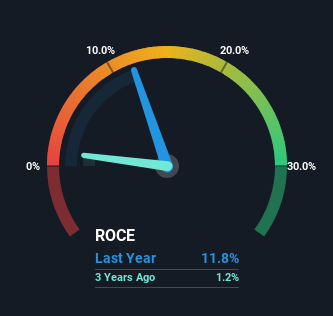Argan (NYSE:AGX) Hasn't Managed To Accelerate Its Returns
If we want to find a potential multi-bagger, often there are underlying trends that can provide clues. Amongst other things, we'll want to see two things; firstly, a growing return on capital employed (ROCE) and secondly, an expansion in the company's amount of capital employed. This shows us that it's a compounding machine, able to continually reinvest its earnings back into the business and generate higher returns. However, after briefly looking over the numbers, we don't think Argan (NYSE:AGX) has the makings of a multi-bagger going forward, but let's have a look at why that may be.
Return On Capital Employed (ROCE): What Is It?
For those who don't know, ROCE is a measure of a company's yearly pre-tax profit (its return), relative to the capital employed in the business. Analysts use this formula to calculate it for Argan:
Return on Capital Employed = Earnings Before Interest and Tax (EBIT) ÷ (Total Assets - Current Liabilities)
0.12 = US$34m ÷ (US$564m - US$274m) (Based on the trailing twelve months to October 2023).
Thus, Argan has an ROCE of 12%. In absolute terms, that's a satisfactory return, but compared to the Construction industry average of 9.8% it's much better.
See our latest analysis for Argan
In the above chart we have measured Argan's prior ROCE against its prior performance, but the future is arguably more important. If you're interested, you can view the analysts predictions in our free report on analyst forecasts for the company.
What Does the ROCE Trend For Argan Tell Us?
Over the past five years, Argan's ROCE has remained relatively flat while the business is using 28% less capital than before. To us that doesn't look like a multi-bagger because the company appears to be selling assets and it's returns aren't increasing. You could assume that if this continues, the business will be smaller in a few year time, so probably not a multi-bagger.
Another point to note, we noticed the company has increased current liabilities over the last five years. This is intriguing because if current liabilities hadn't increased to 49% of total assets, this reported ROCE would probably be less than12% because total capital employed would be higher.The 12% ROCE could be even lower if current liabilities weren't 49% of total assets, because the the formula would show a larger base of total capital employed. Additionally, this high level of current liabilities isn't ideal because it means the company's suppliers (or short-term creditors) are effectively funding a large portion of the business.
What We Can Learn From Argan's ROCE
It's a shame to see that Argan is effectively shrinking in terms of its capital base. And investors may be recognizing these trends since the stock has only returned a total of 12% to shareholders over the last five years. Therefore, if you're looking for a multi-bagger, we'd propose looking at other options.
On a final note, we've found 1 warning sign for Argan that we think you should be aware of.
While Argan isn't earning the highest return, check out this free list of companies that are earning high returns on equity with solid balance sheets.
Have feedback on this article? Concerned about the content? Get in touch with us directly. Alternatively, email editorial-team (at) simplywallst.com.
This article by Simply Wall St is general in nature. We provide commentary based on historical data and analyst forecasts only using an unbiased methodology and our articles are not intended to be financial advice. It does not constitute a recommendation to buy or sell any stock, and does not take account of your objectives, or your financial situation. We aim to bring you long-term focused analysis driven by fundamental data. Note that our analysis may not factor in the latest price-sensitive company announcements or qualitative material. Simply Wall St has no position in any stocks mentioned.

